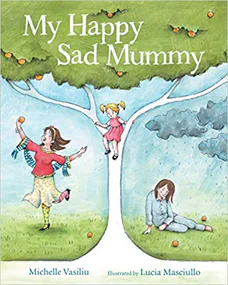My Happy Sad Mummy

Recommended Age Range: Preschool through 1st grade.
Publisher's Summary:
Sometimes Mummy has happy days, where she talks and laughs all day long. Sometimes Mummy is sad. She cries all day and stays in bed. Sometimes she’s so sad she has to go to hospital. The symptoms of a mental illness can be challenging enough for adults to understand and live with. For a child whose parent lives with bipolar disorder, witnessing and experiencing the highs and lows that this particular mental illness brings with it can be very difficult for a child to process. ‘My Happy Sad Mummy’ provides both a starting point; for the necessary dialogue that will lead the child to a clearer awareness and understanding of their parent’s illness, as well as comfort; to know that their experience is a shared one.

Dr. Annie's Takeaways
Recommended for: Exclusively for young children with parents or caregivers with Bipolar I Disorder who have been hospitalized or will likely need to be hospitalized. This book isn’t perfect. The mother has “happy” days and “sad” days, which isn’t an accurate representation of manic or depressive episodes for most people, and it’s just not a particularly engaging story. But it does introduce the idea of a parent having up and down moods and needing to be hospitalized. Its primary message is that no matter what, the child is loved by their parent with bipolar disorder, and they will be taken care of even if their parent with bipolar disorder is not always able to take care of them.
Would a child like it? Probably not. It’s not a particularly engaging story. But it’s an acceptably useful enough book to make it onto the Bookshelf given the lack of better alternatives. I’d love to replace it with an upgrade one of these days.
Evidence-Based Practices:
Psychoeducation
Tone: Matter-of-fact, a bit sweet
Story Quality: There are very few picture books about bipolar disorder, and almost all of them feature polar bears and wildly inaccurate presentations of bipolar disorder. This book doesn’t feature a particularly compelling narrative, poetic language, or vibrant characters, but it’s less painful to read than its competitors. It’s fairly sweet and a starting point to talk with a child about having a parent with bipolar disorder.
Illustrations: Cozy watercolor illustrations.
Representation: This story is written from the perspective of a young White girl. Her mother is White and has bipolar disorder (seemingly Bipolar I). She has a White father and White grandparents. They live in a house with a large yard.
Psychological Practices: This book introduces the idea of a parent with widely fluctuating moods who sometimes needs to take medicine and go to the hospital for treatment. For unknown reasons, it never uses the term bipolar disorder, but it’s clear this is the mother’s diagnosis. The story reassures children that someone (in this story, the father and grandparents) will be there to take care of them when a parent is unable to, and it reminds them that their parent still loves them even when they’re unwell. It briefly touches on the girl’s feelings about her mother being in the hospital (sad), and describes a visit to the hospital when she brings her mother flowers. It ends with the lines, “Sometimes Mummy is very happy. Sometimes she’s very sad. Sometimes Mummy’s in hospital. Sometimes she’s at home. But always I love her and she loves me.” I appreciate that it doesn’t pretend that Mummy will never struggle with her mood again, but it reinforces the fact that the child is loved no matter what and that there will be someone to care for them.
Concerns: Most manic episodes aren’t purely a happy experience. In fact, less pleasurable feelings like irritability and paranoia are often dominant components. These aspects can be as frightening to children as depressive episodes, or even moreso. It’s something of a misnomer that manic episodes are happy and depressive episodes are sad. This book is intended for young children, so I think it’s an acceptable inaccuracy, but I wish the mummy in this story exhibited some irritability during her manic episodes to make it more relatable to readers. It’s also worth noting that the father in the book explains that Mummy’s brain “isn’t working properly,” which could be a useful framing if a parent is frightening a child or saying hurtful things, but could also be a stigmatizing way of framing a parent’s symptoms.
